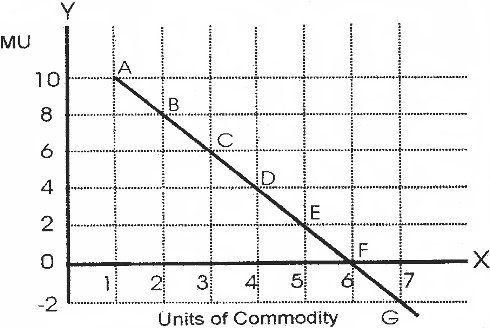“Other things remaining the same when a person takes successive units of a commodity, the marginal utility diminishes constantly”.
The marginal utility of a commodity diminishes at the consumer gets larger quantities of it. Marginal utility is the change in the total utility resulting from one unit change in the consumption of a commodity per unit of time.
Assumptions:
Following are the assumptions of the law of diminishing marginal utility.
- The utility is measurable and a person can express the utility derived from a commodity in qualitative terms such as 2 units, 4 units and 7 units etc.
- A rational consumer aims at the maximization of his utility.
- It is necessary that a standard unit of measurement is constant
- A commodity is being taken continuously. Any gap between the consumption of a commodity should be suitable.
- There should be proper units of a good consumed by the consumer.
- It is assumed that various units of commodity homogeneous in characteristics.
- The taste of the consumer remains same during the consumption o the successive units of commodity.
- Income of the consumer remains constant during the operation of the law of diminishing marginal utility.
- It is assumed that the commodity is divisible.
- There should be not change in fashion. For example, if there is a fashion of lifted shirts, then the consumer may have no utility in open shirts.
- It is assumed that the prices of the substitutes do not change. For example, the demand for CNG increases due to rise in the prices of petroleum and these price changes effect the utility of CNG.
Explanation with Schedule and Diagram:
We assume that a man is very thirsty. He takes the glasses of water successively. The marginal utility of the successive glasses of water decreases, ultimately, he reaches the point of satiety. After this point the marginal utility becomes negative, if he is forced further to take a glass of water. The behavior of the consumer is indicated in the following schedule:
| Units of commodity |
Marginal utility |
Total utility |
| 1st glass | 10 | 10 |
| 2nd glass | 8 | 18 |
| 3rd glass | 6 | 24 |
| 4th glass | 4 | 28 |
| 5th glass | 2 | 30 |
| 6th glass | 0 | 30 |
| 7th glass | -2 | 28 |
On taking the 1st glass of water, the consumer gets 10 units of utility, because he is very thirsty. When he takes 2nd glass of water, his marginal utility goes down to 8 units because his thirst has been partly satisfied. This process continues until the marginal utility drops down to zero which is the saturation point. By taking the seventh glass of water, the marginal utility becomes negative because the thirst of the consumer has already been fully satisfied.
The law of diminishing marginal utility can be explained by the following diagram drawn with the help of above schedule:

In the above figure, the marginal utility of different glasses of water is measured on the y-axis and the units (glasses of water) on X-axis. With the help of the schedule, the points A, B, C, D, E, F and G are derived by the different combinations of units of the commodity (glasses of water) and the marginal utility gained by different units of commodity. By joining these points, we get the marginal utility curve. The marginal utility curve has the downward negative slope. It intersects the X-axis at the point of 6th unit of the commodity. At this point “F” the marginal utility becomes zero. When the MU curve goes beyond this point, the MU becomes negative. So there is an inverse functional relationship between the units of a commodity and the marginal utility of that commodity.
Limitations:
The limitations or exceptions of the law of diminishing marginal utility are as follows:
- The law does not hold well in the rare collections. For example, collection of ancient coins, stamps etc.
- The law is not fully applicable to money. The marginal utility of money declines with richness but never falls to zero.
- It does not apply to the knowledge, art and innovations.
- The law is not applicable for precious goods.
- Historical things are also included in exceptions to the law.
- Law does not operate if consumer behaves in irrational manner. For example, drunkard is said to enjoy each successive peg more than the previous one.
- Man is fond of beauty and decoration. He gets more satisfaction by getting the above merits of the commodities.
- If a dress comes in fashion, its utility goes up. On the other hand its utility goes down if it goes out of fashion.
- The utility increases due to demonstration. It is a natural element.
Importance of the Law of Diminishing Marginal Utility:
The importance or the role of the law of diminishing marginal utility is as follows:
- By purchasing more of a commodity the marginal utility decreases. Due to this behaviour, the consumer cuts his expenditures to that commodity.
- In the field of public finance, this law has a practical application, imposing a heavier burden on the rich people.
- This law is the base of some other economic laws such as law of demand, elasticity of demand, consumer surplus and the law of substitution etc.
- The value of commodity falls by increasing the supply of a commodity. It forms a basis of the theory of value. In this way prices are determined
One thought on “Law of Diminishing Marginal utility”